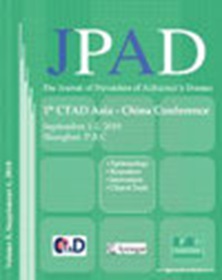Neuropsychiatric Symptoms in Dementia: Overview and Measurement Challenges.
IF 8.5
3区 医学
Q1 CLINICAL NEUROLOGY
引用次数: 25
Abstract
Neuropsychiatric symptoms (NPS) are now known to occur almost universally over the course of dementia, Alzheimer’s in particular (1, 2). They also occur with higher-than-expected frequency in the dementia prodrome of mild cognitive impairment (3). Further, NPS in the form of “mild behavioral impairment,” in the absence of cognitive impairment, may constitute a dementia prodrome (4). NPS are associated with a number of adverse outcomes including accelerated transition from prodrome to dementia (4), and faster progression from early dementia to severe dementia or death [Peters et al, Am J Psychiatry, in press], as well as serious adverse effects for patients and caregivers such as greater disability, worse quality of life, earlier institutionalization, increased burden, and higher health care costs (2). Given their central importance, NPS are increasingly a focus of study with an eye to the development of effective treatments. The heterogeneity of NPS complicates treatment development; they are heterogeneous in both phenomenology and cause. A wide range of symptoms has been reported although they tend to aggregate into predictable groups, especially in milder disease (5). The most reproducible groupings have been: depression, apathy, psychosis, agitation, and sleep disturbances [6]. Recent treatment development has targeted presumptive or proposed syndromes in these areas (7, 8). From the point of view of cause, NPS likely result from several interacting factors. The brain neurodegenerative process, through disruption of brain circuits involved in affect, behavior, motivation, or perception, is central to their emergence either through direct damage to circuits, or through creating vulnerabilities acted on by the environment. Additionally, NPS may result because of difficulties individuals face adapting to the surroundings as they lose cognitive abilities. Further, NPS may arise because of unmet needs, acute comorbid illnesses causing confusional states akin to delirium, or environments and caregiving that are mismatched with the patient’s current capabilities and skills [Kales et al, BMJ, under review). Treatment development for NPS has to grapple with a number of issues concurrently. Efforts have included the development of nonpharmacologic approaches (9), as well as pharmacologic approaches. The latter initially involved importation of psychopharmaca developed for the treatment of psychiatric disorders into this setting with mixed results (2, 6). Of particular concern has been unexpected serious risks associated with these medications, antipsychotics in particular (6). Central to treatment development for NPS is clinical measurement. As there are no specific “direct” measures of NPS, as with measures of cognitive functioning, measurement relies on reporting of observable behaviors and mental states by patients and others. Measurement is affected by a number of variables. These include aspects of the cognitive disorder that limit patient ability to reveal mental state, or lead to forgetting prior experiences and behaviors. As a result, measurement depends on input from caregivers who themselves are “filters,” leading at times to biased reporting in particular when caregivers suffer from psychological disturbances—a common finding in dementia caregivers (10). Further, because NPS are episodic, relapsing and remitting frequently, often “real-time” in response to environmental situations, the quantification of NPS frequency and severity over longer time frames is difficult. In the last several decades a number of measures have been developed for the study of NPS. The most widely used are discussed in the most recent Handbook of Psychiatric Measures (11). They include “broad spectrum” measures to quantify the occurrence, frequency, severity, or other attributes of NPS (e.g., associated caregiver distress), without going into depth for individual disturbances. Other measures are “narrow spectrum” focused on individual disturbances such as depression, apathy, or agitation. Some measures acquire information about the NPS entirely from structured caregiver interviews. Other measures use structured patient interviews, and yet others combinations of these approaches. The introduction of rating judgments from experienced clinicians, following the LED standard (longitudinal, expert, all data) is the optimal way of quantifying NPS; it is also the most complicated, costly, and time-consuming (12). Development of the Neuropsychiatric Inventory-clinician rating (NPI-C) (13), has produced a versatile measure that can be used as a broad spectrum measure based entirely on caregiver report or as a narrow spectrum measure of a particular domain, such as agitation. In the latter case NPI-C incorporates information from patient, caregiver and other sources and applies clinician judgment in making final ratings. NPI-C has better inter-rater reliability then the conventional NPI (13) perhaps because the latter is highly structured, based only on caregiver report, and not very sensitive to change (14). Rating judgments from well-trained clinicians are least affected by biases related to caregiver report. In summary, NPS are a central focus of study and treatment development in the context of Alzheimer’s and other neurodegenerative brain diseases. It should be no surprise that such symptoms are universal in diseases that affect key brain areas regulating behavior, or disrupt multiple brain areas over time. Despite heterogeneity in phenomenology and etiology, treatment development for NPS has accelerated in the last few years (15) with the promise of more effective novel treatments on the immediate horizon.痴呆的神经精神症状:概述和测量挑战。
神经精神症状(NPS)现在被认为几乎普遍发生在痴呆症的过程中,尤其是阿尔茨海默氏症(1,2)。它们在轻度认知障碍的痴呆前驱症状中也以高于预期的频率发生(3)。此外,NPS以“轻度行为障碍”的形式出现,在没有认知障碍的情况下,可能构成痴呆前驱症状(4)。NPS与许多不良后果相关,包括从前驱症状到痴呆的加速转变(4),从早期痴呆到严重痴呆或死亡的加速进展[Peters等人,Am J Psychiatry, in press],以及对患者和护理人员的严重不良影响,如更严重的残疾,更差的生活质量,更早的机构,增加的负担,鉴于其核心重要性,NPS正日益成为研究的焦点,着眼于开发有效的治疗方法。NPS的异质性使治疗发展复杂化;它们在现象学和原因上都是异质的。各种各样的症状已被报道,但它们往往聚集成可预测的组,特别是在较轻的疾病中(5)。最可重复的组是:抑郁、冷漠、精神病、躁动和睡眠障碍[10]。最近的治疗发展针对这些领域的推定或建议综合征(7,8)。从病因的角度来看,NPS可能是由几个相互作用的因素引起的。脑神经退行性过程,通过破坏涉及情感、行为、动机或感知的大脑回路,是通过直接损害回路或通过在环境作用下产生脆弱性而出现的核心。此外,NPS可能是因为个体在失去认知能力时难以适应周围环境而导致的。此外,NPS的出现可能是由于需求未得到满足,急性合并症导致类似谵妄的混乱状态,或者环境和护理与患者当前的能力和技能不匹配[Kales等人,BMJ,正在审查中]。NPS的治疗发展必须同时解决许多问题。努力包括非药物方法的发展(9),以及药物方法。后者最初涉及为治疗精神疾病而开发的精神药物的进口,结果好坏参半(2,6)。特别值得关注的是与这些药物,特别是抗精神病药物相关的意外严重风险(6)。NPS治疗发展的核心是临床测量。与认知功能的测量一样,NPS没有具体的“直接”测量方法,测量依赖于对患者和其他人可观察到的行为和精神状态的报告。测量受到许多变量的影响。这些包括认知障碍的一些方面,这些方面限制了患者揭示精神状态的能力,或导致忘记先前的经历和行为。结果,测量依赖于照顾者的输入,他们本身就是“过滤器”,有时导致有偏见的报告,特别是当照顾者遭受心理障碍时——这在痴呆症照顾者中很常见(10)。此外,由于NPS是偶发性的,经常复发和缓解,通常是对环境情况的“实时”反应,因此很难在较长时间内量化NPS的频率和严重程度。在过去的几十年里,已经开发了许多用于研究NPS的措施。最广泛使用的是在最近的《精神病学测量手册》(11)中讨论的。它们包括“广谱”测量,以量化NPS的发生、频率、严重程度或其他属性(例如,相关的照顾者困扰),而不深入个人干扰。其他措施是“窄谱”,侧重于个体干扰,如抑郁、冷漠或躁动。一些措施完全从结构化的照顾者访谈中获取有关NPS的信息。其他措施使用结构化的患者访谈,还有其他方法的组合。引入经验丰富的临床医生的评分判断,遵循LED标准(纵向,专家,所有数据)是量化NPS的最佳方法;它也是最复杂、最昂贵、最耗时的。神经精神病学量表-临床医师评分(NPI-C)(13)的发展,产生了一种多功能的测量方法,可以作为完全基于护理者报告的广谱测量方法,也可以作为特定领域的窄谱测量方法,如躁动。在后一种情况下,NPI-C结合了来自患者、护理者和其他来源的信息,并在做出最终评分时应用临床医生的判断。 NPI- c比传统NPI具有更好的评估者间可靠性(13),这可能是因为后者是高度结构化的,仅基于护理者报告,对变化不太敏感(14)。来自训练有素的临床医生的评级判断受与护理人员报告相关的偏见影响最小。总之,NPS是阿尔茨海默病和其他神经退行性脑疾病研究和治疗发展的中心焦点。这些症状在影响调节行为的关键大脑区域的疾病中普遍存在,或者随着时间的推移破坏多个大脑区域,这应该不足为奇。尽管在现象学和病因学上存在异质性,但在过去几年中,NPS的治疗发展已经加速(15),更有效的新治疗方法有望在不久的将来出现。
本文章由计算机程序翻译,如有差异,请以英文原文为准。
求助全文
约1分钟内获得全文
求助全文
来源期刊

Jpad-Journal of Prevention of Alzheimers Disease
CLINICAL NEUROLOGY-
自引率
7.80%
发文量
85
期刊介绍:
The JPAD « Journal of Prevention of Alzheimer’Disease » will publish reviews, original research articles and short reports to improve our knowledge in the field of Alzheimer prevention including : neurosciences, biomarkers, imaging, epidemiology, public health, physical cognitive exercise, nutrition, risk and protective factors, drug development, trials design, and heath economic outcomes.
JPAD will publish also the meeting abstracts from Clinical Trial on Alzheimer Disease (CTAD) and will be distributed both in paper and online version worldwide.
 求助内容:
求助内容: 应助结果提醒方式:
应助结果提醒方式:


